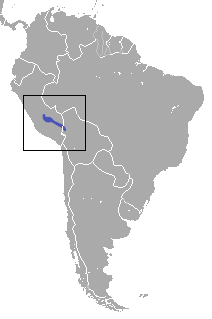Incan caenolestid facts for kids
Quick facts for kids Incan caenolestid |
|
|---|---|
| Conservation status | |
| Scientific classification | |
| Genus: |
Lestoros
|
| Species: |
inca
|
 |
|
| Range of the Incan shrew opossum | |
| Synonyms | |
|
Caenolestes gracilis (Bublitz, 1987) |
|
The Incan caenolestid (Lestoros inca) is a small animal. It is also called the Incan shrew opossum or Peruvian caenolestid. You can find it in the southern Andes mountains of Peru.
An English zoologist named Oldfield Thomas first described this animal in 1917. It is about 9 to 11.5 centimeters (3.5 to 4.5 inches) long, not including its tail. It weighs between 25 and 32 grams (about 1 ounce).
The Incan caenolestid has a brown back and a lighter belly. We do not know much about how it behaves. It seems to live on the ground and is active at night. It eats small invertebrates and insects. This animal lives in elfin and secondary forests. The IUCN says it is of "least concern" for its survival.
Contents
About the Incan Shrew Opossum
The Incan caenolestid is the only member of its group, called Lestoros. It belongs to the family Caenolestidae, which are known as shrew opossums.
Oldfield Thomas, an English zoologist, first described this animal in 1917. He named it Orolestes inca. In 1934, it was given its current scientific name, Lestoros inca. Scientists have found fossils of shrew opossums that are nearly 55 million years old.
For a while, scientists thought the Incan caenolestid was closely related to other common shrew opossums. But later, they saw that it looked different. Studies now show that the Incan caenolestid is more closely related to the long-nosed caenolestid than to other common shrew opossums.
What the Incan Caenolestid Looks Like
The Incan caenolestid has a long snout and small eyes, much like other shrew opossums. A study in 2013 looked closely at its body features. It found that the Incan caenolestid looked more like common shrew opossums than the long-nosed caenolestid.
Males and females of this species look very similar. Their head and body are usually 9 to 11.5 centimeters (3.5 to 4.5 inches) long. Their tail can be 9.5 to 13.5 centimeters (3.7 to 5.3 inches) long. Their ears are small, about 1.4 to 1.7 centimeters (0.5 to 0.7 inches) long. They weigh between 25 and 32 grams (0.9 to 1.1 ounces).
Their fur is dark brown on the back. Their belly is usually a lighter brown color. This animal has a strong skull and a shorter jaw. This might mean it can eat tougher foods than other shrew opossums. Its teeth are long and blade-like. This suggests it eats soft invertebrates.
How the Incan Caenolestid Lives
We do not know much about the daily life of the Incan caenolestid. Scientists believe it lives on the ground. It is also a nocturnal animal, meaning it is active at night.
Like other shrew opossums, it eats insects and small invertebrates. It can also have tiny creatures called ectoparasites living on its body.
Where the Incan Caenolestid Lives
The Incan caenolestid lives in moist places. These include elfin forests, secondary forests, and areas with Baccharis shrubs. You can find them at high altitudes, from 2,100 to 3,600 meters (6,900 to 11,800 feet) above sea level.
They are mostly found in the southern Andes mountains of Peru. Their home range stretches from southeastern Peru to the far west of Bolivia.
The IUCN lists the Incan caenolestid as "least concern". This means it is not currently in danger of disappearing. This is because it lives in a wide area, likely has a large population, and can be found in several protected places. There are no big threats to its survival right now.
See also
 In Spanish: Ratón runcho andino para niños
In Spanish: Ratón runcho andino para niños


